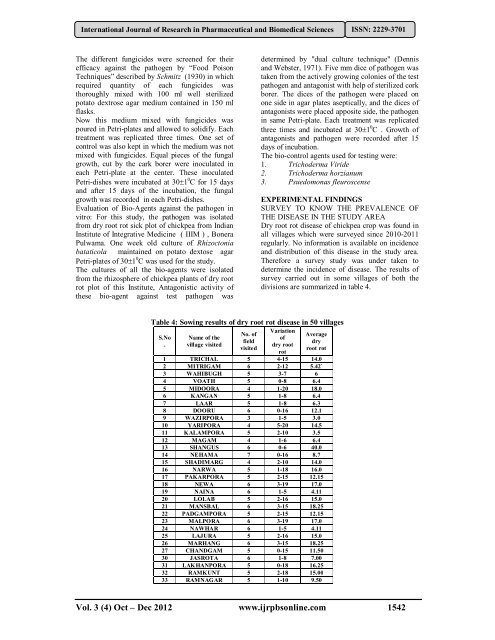Dry root Rot Caused by Rhizoctonia bataticola - International ...
Dry root Rot Caused by Rhizoctonia bataticola - International ...
Dry root Rot Caused by Rhizoctonia bataticola - International ...
Create successful ePaper yourself
Turn your PDF publications into a flip-book with our unique Google optimized e-Paper software.
<strong>International</strong> Journal of Research in Pharmaceutical and Biomedical Sciences ISSN: 2229-3701The different fungicides were screened for theirefficacy against the pathogen <strong>by</strong> “Food PoisonTechniques” described <strong>by</strong> Schmitz (1930) in whichrequired quantity of each fungicides wasthoroughly mixed with 100 ml well sterilizedpotato dextrose agar medium contained in 150 mlflasks.Now this medium mixed with fungicides waspoured in Petri-plates and allowed to solidify. Eachtreatment was replicated three times. One set ofcontrol was also kept in which the medium was notmixed with fungicides. Equal pieces of the fungalgrowth, cut <strong>by</strong> the cark borer were inoculated ineach Petri-plate at the center. These inoculatedPetri-dishes were incubated at 301 0 C for 15 daysand after 15 days of the incubation, the fungalgrowth was recorded in each Petri-dishes.Evaluation of Bio-Agents against the pathogen invitro: For this study, the pathogen was isolatedfrom dry <strong>root</strong> rot sick plot of chickpea from IndianInstitute of Integrative Medicine ( IIIM ) , BoneraPulwama. One week old culture of <strong>Rhizoctonia</strong><strong>bataticola</strong> maintained on potato dextose agarPetri-plates of 301 0 C was used for the study.The cultures of all the bio-agents were isolatedfrom the rhizosphere of chickpea plants of dry <strong>root</strong>rot plot of this Institute, Antagonistic activity ofthese bio-agent against test pathogen wasdetermined <strong>by</strong> "dual culture technique" (Dennisand Webster, 1971). Five mm dice of pathogen wastaken from the actively growing colonies of the testpathogen and antagonist with help of sterilized corkborer. The dices of the pathogen were placed onone side in agar plates aseptically, and the dices ofantagonists were placed apposite side, the pathogenin same Petri-plate. Each treatment was replicatedthree times and incubated at 301 0 C . Growth ofantagonists and pathogen were recorded after 15days of incubation.The bio-control agents used for testing were:1. Trichoderma Viride2. Trichoderma horzianum3. Psuedomonas fleuroscenseEXPERIMENTAL FINDINGSSURVEY TO KNOW THE PREVALENCE OFTHE DISEASE IN THE STUDY AREA<strong>Dry</strong> <strong>root</strong> rot disease of chickpea crop was found inall villages which were surveyed since 2010-2011regularly. No information is available on incidenceand distribution of this disease in the study area.Therefore a survey study was under taken todetermine the incidence of disease. The results ofsurvey carried out in some villages of both thedivisions are summarized in table 4.Table 4: Sowing results of dry <strong>root</strong> rot disease in 50 villagesS.No.Name of thevillage visitedNo. offieldvisitedVariationofdry <strong>root</strong>rotAveragedry<strong>root</strong> rot1 TRICHAL 5 4-15 14.02 MITRIGAM 6 2-12 5.42`3 WAHIBUGH 5 3-7 64 VOATH 5 0-8 6.45 MIDOORA 4 1-20 18.06 KANGAN 5 1-8 6.47 LAAR 5 1-8 6.38 DOORU 6 0-16 12.19 WAZIRPORA 3 1-5 3.010 YARIPORA 4 5-20 14.511 KALAMPORA 5 2-10 3.512 MAGAM 4 1-6 6.413 SHANGUS 6 0-6 40.014 NEHAMA 7 0-16 8.715 SHADIMARG 4 2-10 14.016 NARWA 5 1-18 16.017 PAKARPORA 5 2-15 12.1518 NEWA 6 3-19 17.019 NAINA 6 1-5 4.1120 LOLAB 5 2-16 15.021 MANSBAL 6 3-15 18.2522 PADGAMPORA 5 2-15 12.1523 MALPORA 6 3-19 17.024 NAWHAR 6 1-5 4.1125 LAJURA 5 2-16 15.026 MARHANG 6 3-15 18.2527 CHANDGAM 5 0-15 11.5030 JASROTA 6 1-8 7.0031 LAKHANPORA 5 0-18 16.2532 RAMKUNT 5 2-18 15.0033 RAMNAGAR 5 1-10 9.50Vol. 3 (4) Oct – Dec 2012 www.ijrpbsonline.com 1542
















